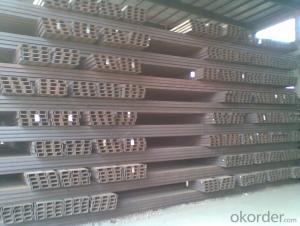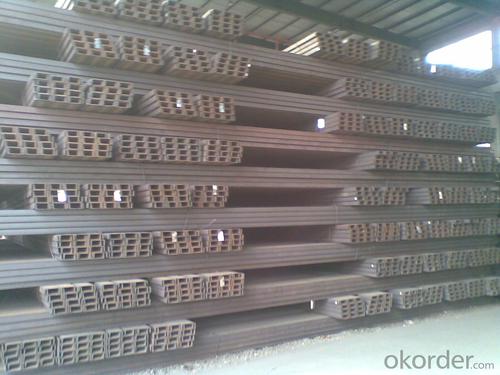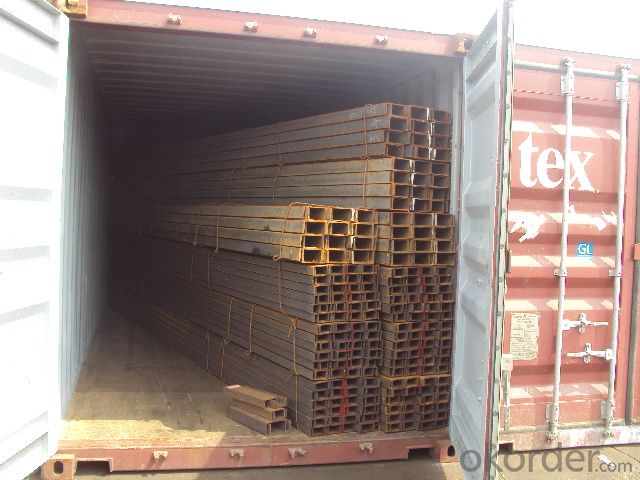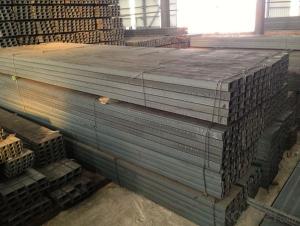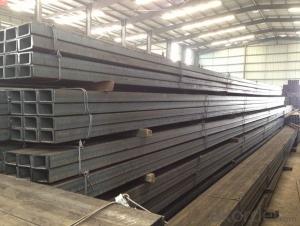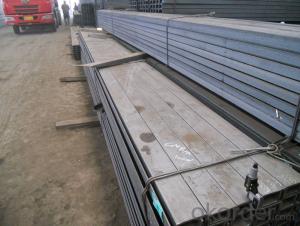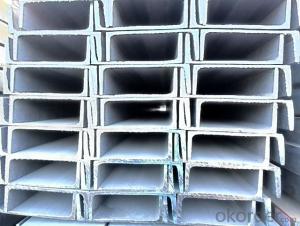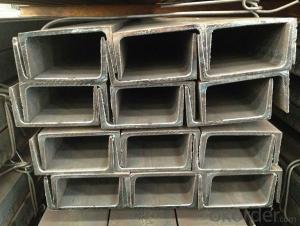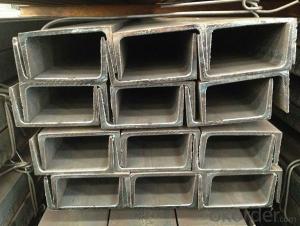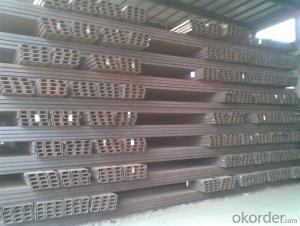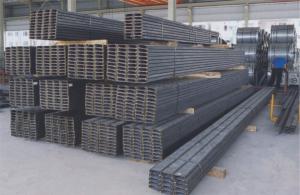Mild Steel U Channels for Structure Construction JIS,GB,UPN,UPE
- Loading Port:
- Tianjin
- Payment Terms:
- TT or LC
- Min Order Qty:
- 25 m.t.
- Supply Capability:
- 200000 m.t./month
OKorder Service Pledge
OKorder Financial Service
You Might Also Like
Product Description:
OKorder is offering Mild Steel U Channels for Structure Construction JIS,GB,UPN,UPE at great prices with worldwide shipping. Our supplier is a world-class manufacturer of steel, with our products utilized the world over. OKorder annually supplies products to European, North American and Asian markets. We provide quotations within 24 hours of receiving an inquiry and guarantee competitive prices.
Product Applications:
Mild Steel U Channels for Structure Construction JIS,GB,UPN,UPE are ideal for structural applications and are widely used in the construction of buildings and bridges, and the manufacturing, petrochemical, and transportation industries.
1. Supporting members, most commonly in the house raising industry to strengthen timber bears under houses. Transmission line towers, etc
2. Prefabricated structure
3. Medium scale bridges
4. It is widely used in various building structures and engineering structures such as roof beams, bridges, transmission towers, hoisting machinery and transport machinery, ships, industrial furnaces, reaction tower, container frame and warehouse etc.
Product Advantages:
Mild Steel U Channels for Structure Construction JIS,GB,UPN,UPE are durable, strong, and resist corrosion.
Main Product Features:
· Premium quality
· Prompt delivery & seaworthy packing (30 days after receiving deposit)
· Corrosion resistance
· Can be recycled and reused
· Mill test certification
· Professional Service
· Competitive pricing
Specifications of Mild Steel U Channels for Structure Construction JIS,GB,UPN,UPE:
| Original Place | Tangshan, China | Brand Name | Bridge |
| Standard | GB707-88, EN100025, JIS G3192, DIN 1026 | ||
| Sizes | 50mm to 300mm | ||
| Sales Volume/Year | 3000MT | ||
| Main Market | Middle East, Africa, Southeast As | ||
1.We are able to provide channel steel of top quality at attractive price.
2.Our products of channel steel have passed ISO9001:2008 Quality Management System Certification.
3. The section of Mild Steel U Channels for Structure Construction JIS,GB,UPN,UPE are as followings in the table.
| JIS U CHANNEL | Standard h | Sectional b | Dimension s | t | Mass: Kg/m |
| (mm) | (mm) | (mm) | (mm) | ||
| 50x25 | 50 | 25 | 3.0 | 6.00 | 2.37 |
| 75X40 | 75 | 40 | 3.8 | 7.00 | 5.30 |
| 75X40 | 75 | 40 | 4.0 | 7.00 | 5.60 |
| 75X40 | 75 | 40 | 4.5 | 7.00 | 5.85 |
| 75X40 | 75 | 40 | 5.0 | 7.00 | 6.92 |
| 100X50 | 100 | 50 | 3.8 | 6.00 | 7.30 |
| 100X50 | 100 | 50 | 4.2 | 6.00 | 8.03 |
| 100X50 | 100 | 50 | 4.5 | 7.50 | 8.97 |
| 100X50 | 100 | 50 | 5.0 | 7.50 | 9.36 |
| 125X65 | 125 | 65 | 5.2 | 6.80 | 11.66 |
| 125X65 | 125 | 65 | 5.3 | 6.80 | 12.17 |
| 125X65 | 125 | 65 | 5.5 | 8.00 | 12.91 |
| 125X65 | 125 | 65 | 6.0 | 8.00 | 13.40 |
| 150x75 | 150 | 75 | 5.5 | 7.30 | 14.66 |
| 150x75 | 150 | 75 | 5.7 | 10.00 | 16.71 |
| 150x75 | 150 | 75 | 6.0 | 10.00 | 17.90 |
| 150x75 | 150 | 75 | 6.5 | 10.00 | 18.60 |
4. Chemical Compostion of Mild Steel U Channels for Structure Construction JIS,GB,UPN,UPE
| Grade | Element(%) | |||
| C | Mn | P | S | |
| SS330 | -- | -- | ≦0.050 | ≦0.050 |
| SS400 | ||||
| SS490 | ||||
| SS540 | ≦0.30 | ≦1.60 | ≦0.040 | ≦0.040 |
Usage/Applications of Mild Steel U Channels for Structure Construction JIS,GB,UPN,UPE:
Mild Steel U Channels for Structure Construction JIS,GB,UPN,UPE is usually used for building structure, vehicle manufacturing and other industrial structure and often used with i beam.
In details, the channel steel belongs to carbon structural steel which is applied to in the field of construction and machinery. The channel steel is usually used for arch-itechtural structure, and they could be welded in order to support or hang a vari-ety of facilities. They are also usually used in combination with I beam. Generally,the channel steel must possess perfect welding property, riveting property and mechanical property and so on.
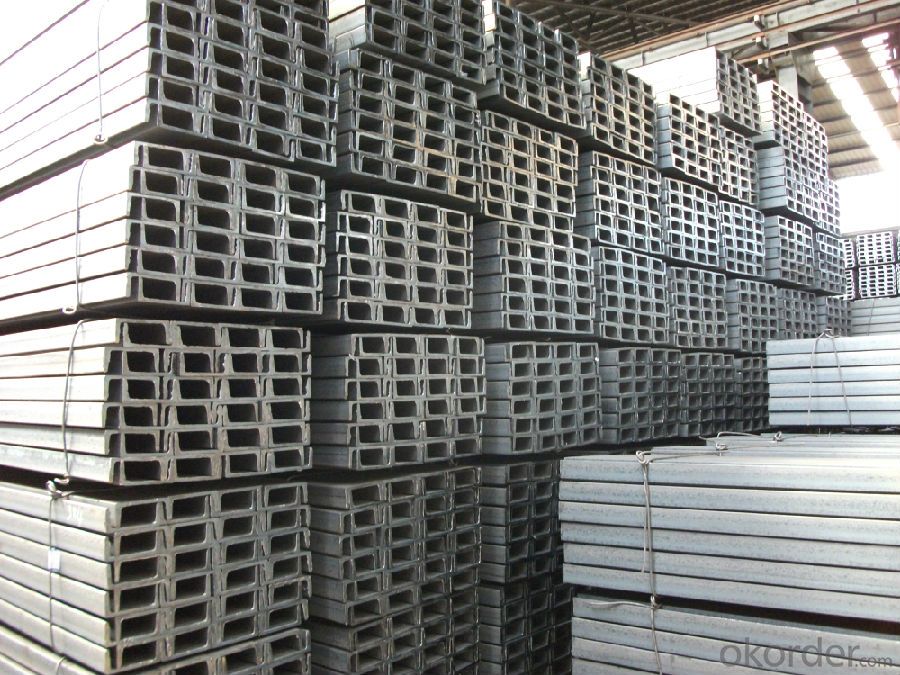
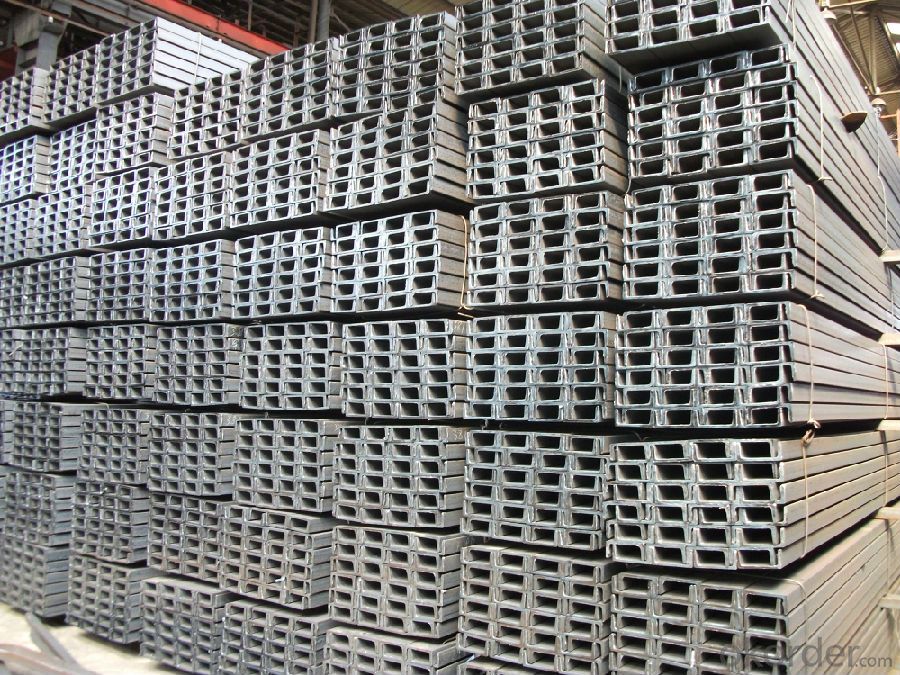

Package & Delivery of Mild Steel U Channels for Structure Construction JIS,GB,UPN,UPE:
The steel u channel will be packed in bundle with steel wire at each end of every bundle and color marking in order to help the customer to recognize his goods more easily at sight.
And steel u channel could be loaded into 20ft or 40ft container, or by bulk cargo. If the weight of each bundle reaches less than 3.5 mt, the loading by break bulk cargo should be choosed. When the weight of each bundle reaches less than 3mt, the loading by container should be choosed.
As for the transportaion from mill to loading port, the truck will be usually used. And the maximum quantity for each truck is 40mt.
All in all, we could do in accordance with customer's request.
Production Flow of Mild Steel U Channels for Structure Construction JIS,GB,UPN,UPE:
1.The steel billet shall be heated in the high temperature furnace.
2. The heated steel billet shall be rolled five to nine times with the aim of shaping the general figure of steel u channel.
3. The rolled steel u channel should be put onto the cooling bed to make the temperature low.
4. The steel u channel should be straighted on the straightener.
5. The straighted steel u channel will be cut into meters by saw, as per customer's requirements.
Outdoor leisure chair is living in a very common chairs, we when not to use the can to its folding and unfolding.
Outdoor leisure chair is designed according to human engineering, not only in the folding retractable is very convenient and dual-purpose chair bed. Tube is to use it as a chair or as a bed to use, you can sleep on it. Is the home travel, outdoor leisure necessary products.
Outdoor leisure chairs can be generally classified into three broad categories: steel pipe phosphide folding chair, Oxford cloth folding chair and carbonized bamboo chair folding chair generally use seamless steel tube as raw material, and then some anti oxidation treatment, the dust on the both ends of the steel tube mounted on the plug. The antiseptic effect of oxidation treatment is stronger than. Especially for the sun and beach chairs, it is even more important. Oxford cloth chair has the advantages of easy cleaning, feel good, the advantages of strong moisture absorption ability etc..
Outdoor leisure chair structure as is human body joints in general, every part of it is moving, is generally consists of a cushion, a chair back and leg and several major components, between all parts again by the screw connection. Such a design, not only can play the role of folding, but also allows users to adjust to the appropriate height according to their needs. Many people used in outdoor leisure chairs, do not want to use other chairs.
Steel Channel is a groove-shaped cross-section of the steel strip. Channel mainly used for building structure, curtain wall engineering, machinery manufacturing and other equipment and vehicles. In use required to have good welding, riveting performance and mechanical properties.
Steel Channel refers to a channel hot-rolled, hot-rolled steel sheet production process and, as the ingots are heated to a certain temperature, the basic steel into the thermoplastic state, then formed by rolling mill. Cold-rolled and cold-formed channel steel production process is basically the same, refers to the steel at room temperature through external action, will be made of steel rolled or curved shape needed. Due to the large difference between the two production processes, therefore, the two are very different performance, hot-rolled steel sheet or hot-rolled steel cold-rolled low intensity ratio, but the plastic deformation ability.
The specifications to waist high (h) * leg width (b) * waist thick (d) the number of millimeters expressed as 120 * 53 * 5, showing the high waist of 120 mm, leg width of 53 mm channel, thick waist 5 mm channel, or 12 # channel. Waist high the same channel, if several different legs wide and thick waist also need to model the right plus a b c be distinguished, such as 25a # 25b # 25c # and so on. Under normal circumstances, the same model (the same value) channel, b-type legs wide and thick waist is greater than a number, so the value per unit length of the same channel type, b-type than a heavy type.
- Q: How do steel channels contribute to the overall structural integrity of a building?
- The utilization of steel channels plays a pivotal role in augmenting the overall structural soundness of a building. These essential structural constituents are frequently employed in construction projects due to their exceptional robustness, endurance, and adaptability. Generally, steel channels are fashioned into C-shaped or U-shaped beams using steel, which confers numerous advantages for the structural stability of a building. Primarily, steel channels proficiently distribute and convey loads. As a result of their configuration, steel channels are adept at supporting heavy loads and evenly dispersing them across multiple points. This equitable allocation of weight obviates the occurrence of concentrated stress points, thereby mitigating the risk of structural failure. Additionally, steel channels possess a high load-bearing capacity, enabling them to endure substantial forces and guarantee the overall steadiness of the building. Secondarily, steel channels offer resistance against bending and torsion forces. Their shape and material composition empower them to resist deformation under pressure, guaranteeing that the building maintains its structural integrity even under extreme conditions such as earthquakes or strong winds. By averting excessive deflection, steel channels aid in maintaining the safety and security of the building. Moreover, steel channels boost the rigidity and stability of the structure. By connecting various components of the building, such as beams, columns, and walls, steel channels effectively eliminate any potential weak points or gaps. This comprehensive integration of different elements contributes to the overall strength and stability of the building, precluding any potential structural failures. Lastly, steel channels provide flexibility in design and construction. They can be easily customized to suit specific architectural requirements, allowing for innovative and efficient building designs. The versatility of steel channels empowers architects and engineers to optimize the strength and stability of the structure while preserving aesthetic appeal. In conclusion, steel channels play a significant role in bolstering the overall structural integrity of a building by efficiently distributing and conveying loads, resisting bending and torsion forces, enhancing rigidity and stability, and providing design flexibility. Their strength, durability, and versatility render them an indispensable component in contemporary construction, ensuring the safety and longevity of buildings.
- Q: What are the different methods of painting steel channels?
- There are several methods of painting steel channels, each with its own advantages and considerations. 1. Brush painting: This is the most basic and traditional method of painting steel channels. It involves using a paintbrush to apply paint directly onto the surface of the channel. Brush painting is suitable for smaller projects or areas that require precise and detailed work. However, it can be time-consuming and may result in brush marks or uneven coverage. 2. Spray painting: Spray painting is a popular method for painting steel channels, especially for larger projects or areas that require a smooth and even finish. It involves using a spray gun or aerosol can to apply a fine mist of paint onto the surface. Spray painting allows for quick and efficient coverage, and it can reach difficult-to-access areas. However, it requires proper ventilation and protective equipment to ensure safety. 3. Powder coating: Powder coating is a highly durable and long-lasting method of painting steel channels. It involves applying a dry powder paint onto the surface, which is then cured with heat to form a smooth and protective finish. Powder coating offers excellent resistance against corrosion, chemicals, and UV rays. It is commonly used in industrial applications and provides a wide range of color options. However, powder coating requires specialized equipment and expertise, making it more suitable for professional applications. 4. Electrostatic painting: Electrostatic painting is a technique that uses electrostatic charge to attract paint particles onto the steel channel's surface. It involves using a spray gun that produces a charged paint mist, which is then attracted to the grounded channel. This method ensures even coverage and minimizes overspray. Electrostatic painting is commonly used in situations where a high-quality finish and uniform coating thickness are required. 5. Dip painting: Dip painting involves immersing the steel channel into a tank or container filled with paint. This method is suitable for objects with complex shapes or hard-to-reach areas. The channel is dipped into the paint, allowing it to coat the surface evenly. Dip painting can achieve a uniform finish, but it requires careful control of the immersion process to prevent excess paint buildup or drips. Each method has its own advantages and considerations, and the choice of painting method depends on factors such as the project size, desired finish, durability requirements, and available resources. It is important to consider the specific needs and constraints of the project before selecting the most suitable method for painting steel channels.
- Q: Can steel channels be used for cable management?
- Yes, steel channels can be used for cable management. Steel channels are often used in industrial and commercial settings to organize and protect cables. They provide a durable and secure solution for managing cables by keeping them organized, preventing them from being damaged or tangled, and allowing for easy access and maintenance. Steel channels can be mounted on walls or ceilings and can accommodate various types and sizes of cables. They are particularly useful in environments where there is a need for heavy-duty cable management, such as data centers, manufacturing facilities, and construction sites.
- Q: What are the different methods for joining multiple steel channels together?
- There are several methods for joining multiple steel channels together. Here are some common techniques used in the industry: 1. Welding: This is the most common and widely used method for joining steel channels. Welding involves melting the edges of the channels and fusing them together using heat. Different welding techniques such as arc welding, MIG welding, and TIG welding can be used depending on the thickness and type of steel channels being joined. Welding provides a strong and permanent connection. 2. Bolting: Bolting is another method where steel channels are joined using bolts and nuts. Holes are drilled through the channels at specific intervals and bolts are passed through these holes. Nuts are then tightened on the other side to secure the connection. Bolting is often used when disassembly may be required in the future or for temporary structures. 3. Riveting: Riveting involves using rivets, which are cylindrical metal pins, to join steel channels together. Holes are drilled through the channels, and the rivets are inserted into these holes. The ends of the rivets are then hammered or pressed to secure them in place. Riveting provides a strong and sturdy connection and is often used in structural applications. 4. Adhesive bonding: Adhesive bonding involves using high-strength adhesives to join steel channels together. The channels are cleaned and prepared, and an adhesive is applied to one or both surfaces. The channels are then pressed together and left to cure. Adhesive bonding can provide a strong and durable connection, but it may not be suitable for high-stress applications. 5. Mechanical fasteners: Mechanical fasteners such as clips, brackets, clamps, or connectors can also be used to join steel channels together. These fasteners are designed to provide a secure connection without the need for welding or drilling. They are often used in applications where quick assembly or disassembly is required. It's important to consider the specific requirements of your project, such as load-bearing capacity, structural integrity, and aesthetics, when choosing the method for joining multiple steel channels together. Consulting with a structural engineer or a professional in the field can help determine the most suitable joining method for your specific application.
- Q: Can steel channels be used in interior design applications?
- Certainly, interior design applications can make use of steel channels. With their versatility and durability, steel channels prove to be fitting for various design purposes. They can serve as structural elements, decorative accents, or even functional features within interior spaces. Architectural details, including room dividers, wall paneling, shelving units, and furniture pieces, can creatively incorporate steel channels. By doing so, they lend an industrial and contemporary touch to any interior design style, thanks to their sleek and modern appearance. Moreover, steel channels offer flexibility to interior designers as they can be customized in terms of size, finish, and shape, thus meeting specific design requirements.
- Q: Do steel channels have any specific deflection limitations?
- Yes, steel channels do have specific deflection limitations. The deflection of any structural member, including steel channels, is determined by factors such as the material properties, dimensions, and the applied loads. The maximum allowable deflection for steel channels is typically specified in building codes and industry standards. These limitations are based on the criteria of serviceability, which ensure that the structure remains functional and safe under normal operating conditions. The deflection limits for steel channels vary depending on the specific application and loading conditions. For example, in structural steel design, the deflection limits for beams and columns are typically based on the span-to-depth ratio or a maximum allowable deflection value. In addition to code requirements, engineers also consider the intended use, aesthetics, and occupant comfort when determining deflection limitations. For instance, in buildings where vibrations or excessive deflections could impact sensitive equipment or occupant comfort, stricter deflection criteria may be applied. It is important to consult the relevant building codes, industry standards, and engineering guidelines to determine the specific deflection limitations for steel channels in a given application. Professional structural engineers are responsible for ensuring that the design meets these requirements to ensure the safety and performance of the structure.
- Q: How are the types of I-beam and channel ABC distinguished? Tell me about it, please.
- According to the steel height, waist width, waist thickness to distinguish, C type thickness, thickness is thickest, weight is heaviest
- Q: How are steel channels manufactured?
- Steel channels are manufactured through a process called hot rolling. This method involves heating a billet or a slab of steel to extremely high temperatures, typically around 1200 degrees Celsius. The heated steel is then passed through a series of rollers, which apply pressure to shape and form the steel into the desired channel shape. During the hot rolling process, the steel is gradually shaped and elongated as it passes through the rollers. The rollers are designed in such a way that they have a groove or a cavity that matches the desired shape of the steel channel. As the steel passes through these rollers, it takes the shape of the groove, resulting in the formation of a channel. The hot rolling process also helps in improving the mechanical properties of the steel channels. It refines the grain structure of the steel, making it stronger and more durable. Additionally, hot rolling removes any internal stresses that may have been present in the steel, ensuring a more uniform and consistent product. Once the steel channels are formed, they are typically cut to the desired length and then cooled. The cooling process may involve air cooling or water quenching, depending on the specific requirements of the channel. After cooling, the channels may undergo further processing such as straightening or surface treatment, depending on the intended application. Overall, the manufacturing of steel channels involves a combination of high temperatures, pressure, and shaping processes. This allows for the production of strong and versatile channels that are widely used in various industries such as construction, manufacturing, and infrastructure.
- Q: Can steel channels be used for curtain wall framing?
- Yes, steel channels can be used for curtain wall framing. Steel channels are often used in curtain wall systems for their strength and durability. They provide structural support and are able to withstand the load and pressure from the curtain wall system. Steel channels are versatile and can be designed to fit the specific requirements and dimensions of the curtain wall. Additionally, steel channels can be easily fabricated and installed, making them a popular choice for curtain wall framing.
- Q: How do steel channels contribute to the overall ease of maintenance for a structure?
- Steel channels contribute to the overall ease of maintenance for a structure in several ways. Firstly, steel channels provide structural support and reinforcement to the building, ensuring its stability and longevity. This reduces the need for frequent repairs and maintenance, as the structure can withstand external forces such as wind, earthquakes, and heavy loads without significant damage or deformation. Additionally, steel channels are highly durable and resistant to corrosion, rust, and decay. Unlike other materials such as wood or concrete, steel channels do not rot, warp, or deteriorate over time. This eliminates the need for regular inspections, repairs, or replacements due to structural degradation. Furthermore, steel channels can be easily fabricated and installed, allowing for efficient construction and maintenance processes. The versatility of steel channels enables engineers and architects to design and modify structures with ease, facilitating any necessary repairs or renovations. This results in reduced downtime and disruption during maintenance activities. Moreover, steel channels have a high strength-to-weight ratio, making them lightweight yet incredibly robust. This feature simplifies the transportation and handling of steel channels during maintenance projects. It also reduces the need for extensive structural modifications, as steel channels can often be added or replaced without compromising the overall integrity of the structure. Lastly, steel channels can be fire-resistant, providing an added layer of safety and ease of maintenance. In case of a fire incident, steel channels can help contain the spread of flames, minimize damage, and facilitate the restoration process. This reduces the complexity and cost of maintenance in the event of fire-related incidents. In summary, steel channels contribute to the overall ease of maintenance for a structure by providing structural support, durability, corrosion resistance, ease of fabrication and installation, lightweight design, and fire resistance. These characteristics result in reduced maintenance requirements, increased structural integrity, and improved cost-effectiveness over the lifespan of a building.
Send your message to us
Mild Steel U Channels for Structure Construction JIS,GB,UPN,UPE
- Loading Port:
- Tianjin
- Payment Terms:
- TT or LC
- Min Order Qty:
- 25 m.t.
- Supply Capability:
- 200000 m.t./month
OKorder Service Pledge
OKorder Financial Service
Similar products
Hot products
Hot Searches
Related keywords
